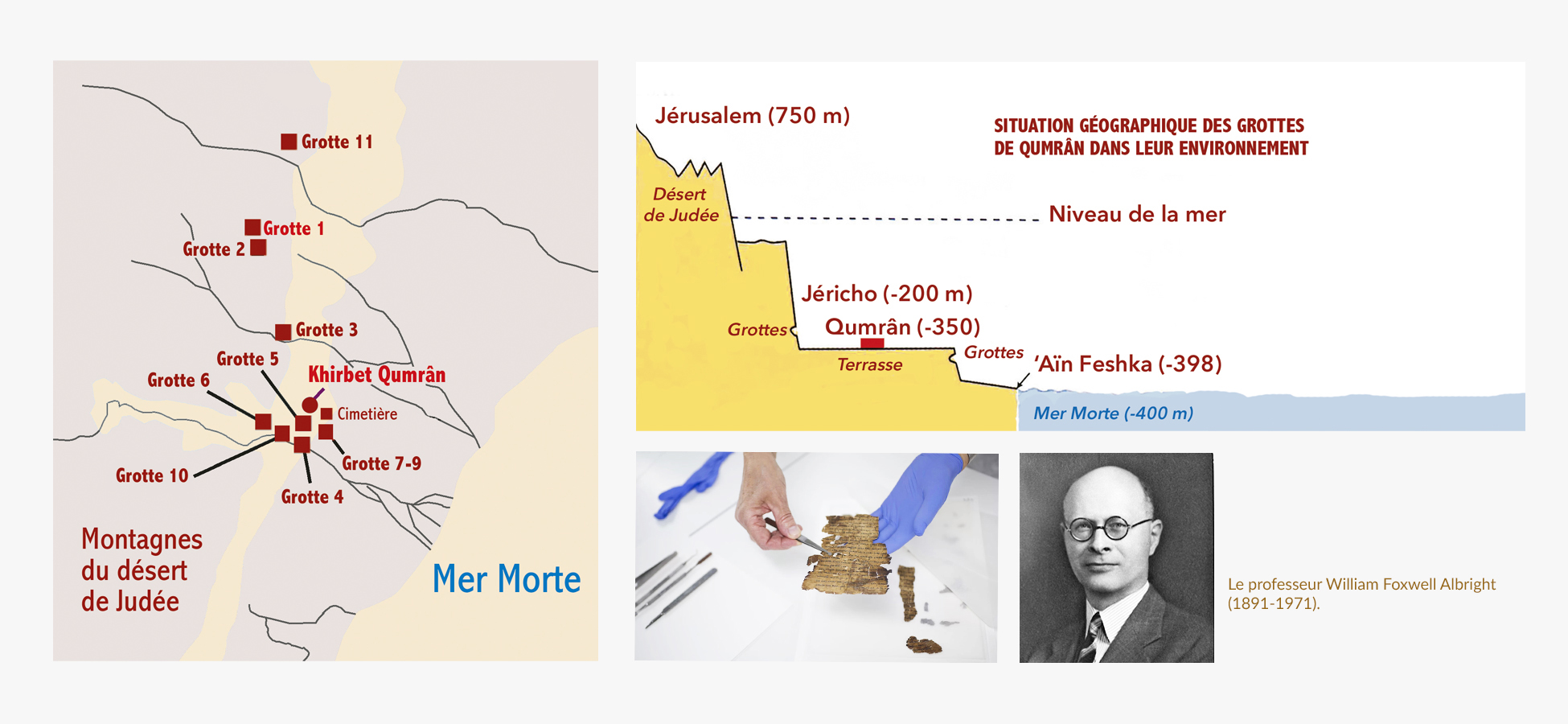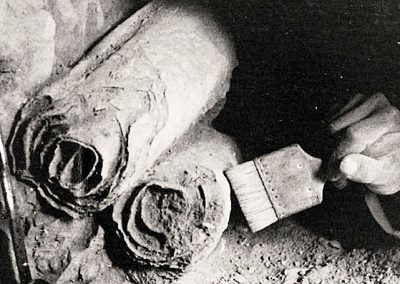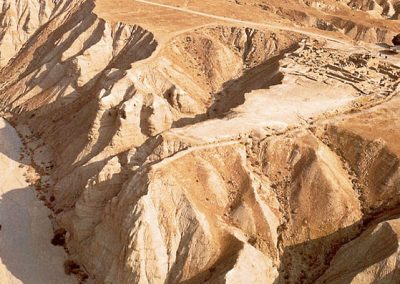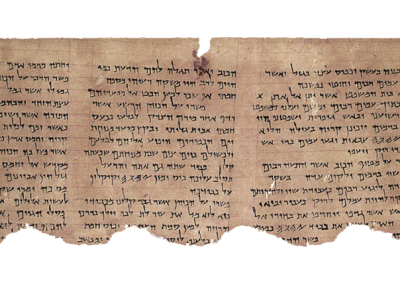
Bible, History, Archaeology
Bible,
History,
Archaeology
The seven manuscripts
cave n°1
Qumran
Contents:
Introduction – General view of the Qumran site – The adventure of discovery – Continued excavation – The seven scrolls reunited at last – The seven rollers – The War Scroll – Hymns and psalms (Hodayot) – A complete copy of the Isaiah scroll – A partial copy of Isaiah – The Genesis Apocrypha – A comment from Habaquq – Discipline Manual – Image gallery – TO FIND OUT MORE
 Introduction
Introduction
Towards the end of 1946 or early 1947, a young shepherd nicknamed ed-Dhib («the Wolf») from the clan of the Ta'amireh, a Bedouin tribe living on the north-western shores of the Dead Sea, fortuitously discovered priceless manuscripts in a cave perched on the side of a hill in the Judah desert, near the archaeological site of Khirbet Qumrân, about a kilometer from the Dead Sea.
Image opposite: several potteries discovered in the Qumran caves © Israel Museum, Jerusalem.
A general view of the site with its cliffs and caves, and the plateau where the Qumran ruins are located. © Alefbet.
The adventures of discovery
Having discovered a cave near a water source called ‘Aïn-Feschka, the cautious young Bedouin returned two days later with a friend to explore the cave. They found themselves in the presence of ten earthenware jars, 63 cm high and around 25 cm wide.
Inside two of these jars, they discovered seven ancient leather scrolls wrapped in linen coated with a bitumen-like substance, perhaps extracted from the Dead Sea.
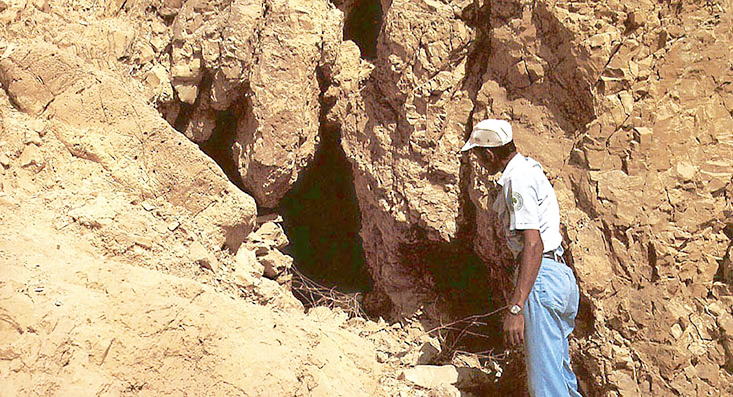
Image opposite: the entrance to Aïn Feschka cave no. 1 at the time of its discovery. Image by DR.
Salahi selected three of the seven scrolls and Kando four, and then set about finding potential buyers. Kando dealt with the metropolitan (a religious title given to certain bishops of the Eastern Churches) of Jerusalem. The latter, unable to identify them, showed them to an employee of the Palestine Archaeological Museum of Jerusalem, to a Dutch researcher at the École Biblique, Father J. van der Ploeg, who identified a passage in the Book of Isaiah (or Isaiah). Visit metropolitan showed his three scrolls to several authorities, who seemed undecided as to their value and content. He finally presented them to a brilliant young researcher attached to the’American School of Oriental Research of Jerusalem, John C. Trever, who dated them to the 2nd century BC. He noted that the writing on the scrolls was similar to that on the Nash Papyrus which scientists dated to around 150 BC. John Trever photographed them and sent them to the Isaiah scroll (1QIsaiahA), from Habakuk's commentary (1Qphab) and the Community rule or Discipline Manual (1Qs) to Professor William Foxwell Albright (1891-1971). This famous American archaeologist and biblical scholar concluded that they must indeed date from the 2nd century BC, and immediately called it an «exceptional find». A few days later, he wrote to John C. Trever: «Congratulations on the discovery of the most important manuscript of modern times! From that moment on, the scientific value of the manuscripts became known, and studies of their contents multiplied.
The precious negatives of the photographs taken by John C. Trever (1916-2006) are preserved in the’Ancient Biblical Manuscript Center of the Clermont School of Theology in Claremont, California.
 Image opposite: Professor Eleazar Sukenik discovers the importance of the Qumran manuscripts. D.R..
Image opposite: Professor Eleazar Sukenik discovers the importance of the Qumran manuscripts. D.R..
For his part, Salahi consulted the son of an Armenian antiquarian in Jerusalem, who in turn contacted Eleazar Sukenik, professor of archaeology at the Hebrew University of Jerusalem. It was through the barbed wire that divided Jerusalem into military zones separating the warring Arab and Jewish sectors that Eleazar Sukenik was able to examine one of the three scrolls, which he eventually acquired along with the other two on his way to Bethlehem. He then had the Hodayot (Hymns and Psalms), the War Scroll and Isaiah (b).
 Continued excavation
Continued excavation
The Arab-Israeli war prevented any scientific investigation. It was only in February 1949 that Professor Lankester Harding, Director of Jordan's Department of Antiquities, and Father Roland de Vaux, Director of the French École Biblique et Archéologique in Jerusalem, undertook the first excavation of Cave N° 1 at ʽAïn Feschka.
In less than four weeks, they unearthed jars, bowls, Roman lamps, pieces of cloth and numerous manuscript fragments, some of which belonged to two of the manuscripts already discovered by the Bedouins.
Between 1947 and 1956, eleven caves were excavated, and among the 100,000 fragments unearthed, 981 manuscripts were identified.
Image opposite: Père de Vaux (center) during excavations at Qumran. École Biblique et Archéologique Française.
The seven scrolls reunited at last
As luck would have it, Yigael Yadin, the son of Professor Eleazar Sukenik, was lecturing in the United States when he read the advertisement in the June 1, 1954 issue of the newspaper Wall Street Journal of the sale of the four remaining rolls by the metropolitan who was trying in vain to find a buyer. Yigael Yadin, after bitter discussions with the intermediaries dispatched by the patriarch, succeeded in obtaining them for the sum of 250,000 dollars at the time, thanks to an advance granted by a New York industrialist, Samuel Gottesman. The seven scrolls were finally reunited.
In February 1955, Israeli Prime Minister Moshe Sharett announced at a press conference that Israel possessed seven manuscripts of the highest antiquity.
 Image opposite: Sanctuary of the House of the Book in Jerusalem. Israel Museum, Jerusalem.
Image opposite: Sanctuary of the House of the Book in Jerusalem. Israel Museum, Jerusalem.
The seven precious scrolls were deposited in a museum specially designed to showcase them: the Sanctuary of the Book. The roof of this museum is reminiscent of the lids of the jars that once contained the scrolls.
An eighth scroll from another cave was added in 1967, in the aftermath of the «Six-Day War». This manuscript, hidden beneath a slab in Kando's dwelling, is the Temple scroll, the longest of the Qumran manuscripts.
The seven scrolls from cave N°1 at Aïn Feschka
1. The War Scroll
Also known as Settlement of the War of the Sons of Light against the Sons of Darkness. It contains nineteen columns of writing, approximately 3 m long and 15 cm high. It is a kind of military manual, containing guidelines for the conduct of holy war between the «Children of the Light» and their enemies, who are seen as striving to oppress God's people in the last days.
2. A collection of Hymns and Psalms (Hodayot)
Visit Psalms of thanksgiving, hymns composed and collected by the Essene community, make up their songbook.
3. A complete copy of the Isaiah scroll
Isaiah's complete scroll, remarkably well preserved, is written on parchment and divided into 54 columns on 17 leaves sewn end-to-end, measuring 7.30 m long by 26 cm high. It is written in square Hebrew, without vocalization signs, which proves its antiquity. Many archaeologists date its production between the end of the second century and the beginning of the first, making it the oldest known complete Hebrew manuscript of a biblical book. What's more, this text agrees in almost every detail with the traditional Hebrew text, as written in the current versions of the Hebrew Bible.
A complete scroll of Isaiah (detail), remarkably well preserved, written on parchment and divided into 54 columns on 17 leaves sewn end to end, 7.30 m long and 26 cm high. Israel Museum, Jerusalem.
4. A partial copy of the Isaiah scroll
The first thirty-seven chapters of the second scroll of the book of Isaiah are seriously damaged, while chapters 38 to 66 are in good condition.
5. The Genesis Apocrypha
A leather scroll, approximately 3 m long and 30 cm high, is an Aramaic version of several chapters of the Book of Genesis, followed by stories about Lamech, Enoch, Noah and Abraham.
6. A Commentary by Habakkuk
It is written on two sheets of brown leather, sewn together to form a scroll about a meter and a half long and 15 cm high. It is a Hebrew text from the Book of Habakkuk, The first two chapters are accompanied by a commentary. He speaks of «the spirit of truth and the spirit of error», and says in his commentary: «God will place the judgment of all nations in the hands of his elect».
7. Manual of Discipline or Community Rule
(Now called Community rule). It is written on five sheets of beige leather, sewn together to form a scroll 2 m long and 24 cm high. It contains rules concerning the sect's own procedures and ceremonies, and describes in detail the «two ways» of good and evil, light and darkness, that God places before man.
Sanctuary of the House of the Book in Jerusalem. Israel Museum in Jerusalem.
Sanctuary of the House of the Book in Jerusalem.
The discovery of a 2-part copper scroll in cave no. 3. It is said to list an immense treasure. Image DR.
The discovery of a 2-part copper scroll in cave no. 3. It would list an immense treasure.
The «Copper Scroll» (3Q15) is one of the Dead Sea Scrolls found at Khirbet Qumran in cave no. 3. Amman Archaeological Museum, Jordan.
The «copper scroll» under examination (3Q15) is one of the Dead Sea Scrolls found at Khirbet Qumran in cave no. 3.
General view of the Qumran site with its cliff and plateau where the ruins are located (right of picture). DR.
General view of the Qumran site with its cliff and plateau where the ruins are located (right of picture).

Find out more
BIOUL Bruno, QUMRÂN and the Dead Sea Scrolls,
Hypotheses and debate
Foreword by Jean-Daniel Dubois, Director of Studies at the École Pratique des Hautes Études.
Éditions François-Xavier de Guibert, 2004, Paris.
Famous the world over, the archaeological site of Qumran and the manuscripts discovered in nearby caves on the north-western shore of the Dead Sea remain largely unknown...

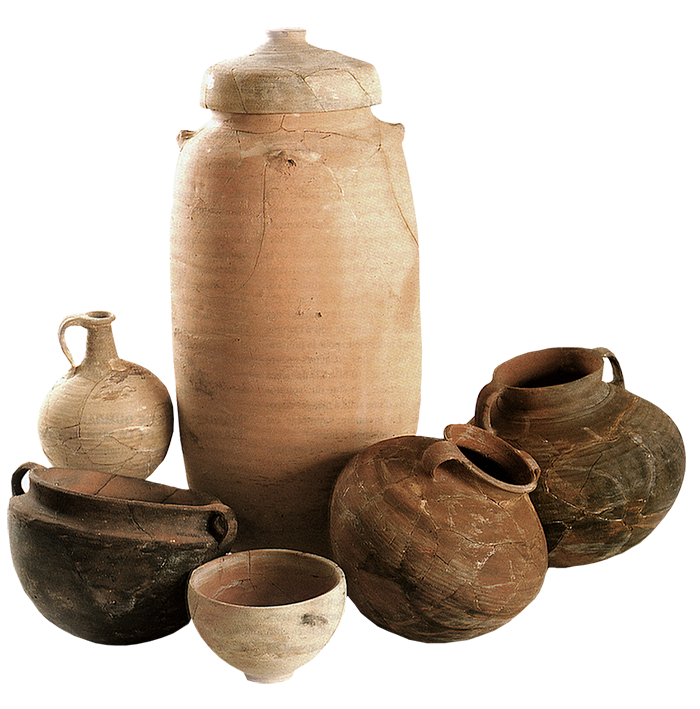 Introduction
Introduction

 Continued excavation
Continued excavation Image opposite: Sanctuary of the House of the Book in Jerusalem. Israel Museum, Jerusalem.
Image opposite: Sanctuary of the House of the Book in Jerusalem. Israel Museum, Jerusalem.